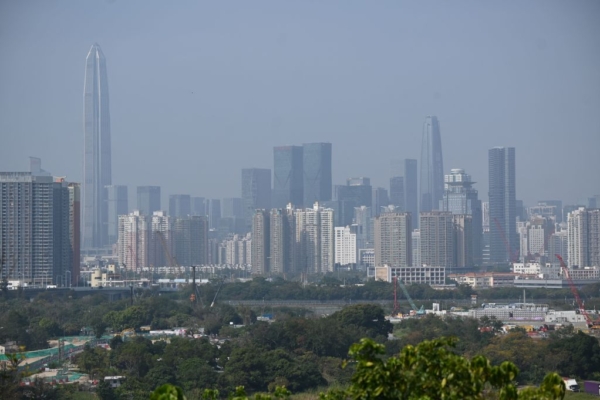In recent days, the second-hand housing transaction data in Shenzhen has been released, showing an increase in trading volume in October. However, many homeowners have been intensifying efforts to sell their properties after the introduction of new housing policies in the real estate market.
To stabilize the real estate market and curb the decline, various departments of the Chinese Communist Party have jointly launched a combination of policies towards real estate, including the comprehensive set of new housing policies introduced at the end of September.
According to a recent report by Shenzhen Special Zone News, after the introduction of the new housing policies in Shenzhen on September 29, market activity has significantly increased. From October 1 to 26, a total of 10,030 units of new commercial residential properties were signed for subscription in Shenzhen, totaling 1.0293 million square meters, with an average daily subscription volume of about 390 units and nearly 40,000 square meters, marking a new high in the trading volume of Shenzhen’s new housing market in recent years.
The second-hand housing market in Shenzhen has also shown some activity. According to statistics from the Shenzhen Real Estate Intermediary Association, from October 7 to October 13, a total of 2,316 second-hand housing units (including self-service) were recorded, representing a 649.5% increase compared to the previous period. From October 14 to October 20, a total of 2,106 second-hand housing units (including self-service) were recorded, although there was a slight decrease compared to the previous period, the absolute value still exceeded 2,000 units.
Despite the new housing policies in Shenzhen, homeowners in the city are accelerating the sale of their properties.
Guangdong blogger Gao Sheng stated that, using a real estate selling platform as an example, within just a week, the number of listings for second-hand houses in Shenzhen surged by 3,119 units. After the new housing policies were introduced on September 29, many people thought that homeowners would choose to increase prices and sell sparingly. However, the actual situation is the opposite of people’s expectations. Data shows that homeowners are accelerating cashing out and exiting the market, even willing to trade volume for price.
Specific data shows that on October 1, Shenzhen saw an increase of 880 new listings, while only 97 units were sold. On October 2, there were 847 new listings and 98 units sold. Looking at a one-week period, this contrast becomes even more apparent with a significant increase in the number of second-hand house listings, while only 243 units were sold.
On a monthly basis, the situation is even more pronounced. Shenzhen saw a total of 15,427 new second-hand house listings, while only 910 units were sold.
These series of data clearly indicate that Shenzhen homeowners are indeed selling their houses. Although this data is only from a single platform, it is evident that the number of houses listed for sale far exceeds those that are actually being sold.
Shell platform data shows that on October 1, there were 482 houses that increased in price. However, it is important to note that there were more listings with reduced prices, with 576 units choosing to lower prices. If we extend the time span to a month, the number of listings with reduced prices reached 27,504 units, while those with increased prices were only 3,798 units, indicating a clear trend of listings with reduced prices overwhelming those with increased prices.
Data from Zhugezhaofang platform indicates a more obvious comparison between houses with increased and decreased prices among the properties for sale in Shenzhen. Decreasing prices have become the mainstream trend. The platform’s transaction volume is also highly noteworthy. After the new policies were introduced on September 30, the platform indeed experienced a peak in transactions with 104 houses sold. However, the next day, on October 1, the number of transactions dropped to 14 units, and on October 2, there were only 8 transactions.
These real data illustrate the current situation of the Shenzhen real estate market. In the current market environment, with the continued trend of homeowners selling their properties, the housing supply in the market will further increase, while it remains to be seen whether demand can keep up. At the same time, for homebuyers, the current property market offers them more choices and negotiation space. They also have greater leverage in price negotiations.
This round of price corrections in Shenzhen, in terms of duration and magnitude of decline, can be considered historic. Currently, the Shenzhen property market is in a crucial adjustment period. The selling behavior of homeowners, the attitude of potential buyers, and changes in supply and demand dynamics will all have a significant impact on the future trend of housing prices.
“A big official,” a blogger who regularly visits property sites in Shenzhen to help citizens buy and sell houses, recently mentioned that he accompanied a distressed homeowner in Shenzhen to view a property that had been on the market for two months without being sold.
He stated that in the Lujing Hongwan area of Futian District in Shenzhen, which is a relatively new luxury residential complex, a two-bedroom unit owned by someone was the cheapest and lowest-priced unit in the entire complex. The current price has now dropped below the purchase price.
He captured images of the two bedrooms, bathrooms, kitchen, and living room of the property.
He remarked that the property is located right next to the subway entrance, within a commercial complex.
According to publicly available information, Lujing Hongwan is situated in the Xia Meilin area of Futian District in Shenzhen, bordering the North Ring Road auxiliary road on the south, and adjacent to Meihua Road and Meilin Road on the east and west, occupying a total area of 32,000 square meters and a total construction area of 360,000 square meters. It consists of a super high-rise landmark building and a large-scale centralized commercial complex seamlessly connected to the subway, making it a very scarce metro-overhead urban complex in the entire Futian area and even nearby regions.

